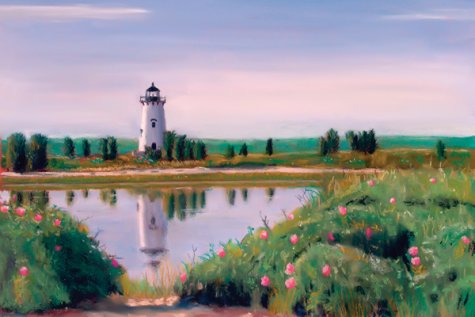ARTIST PROFILE

Debbi and Warren Gaines
Partners in Color and Life
Profiles by Elissa Lash
Debbi and Warren Gaines are restructuring the manner by which they sell their artwork. Sitting in their living room, on an unseasonably mild March day, they explain, they are emerging from what some might call the disappointing closure of their Edgartown gallery, using this as an opportunity to focus more energy on the actual creation of their work. While sipping tea, they run a casual slide show of Debbi’s photographs, subtle and calming, like background music. Occasionally one of their three children makes an appearance, with the mood in their busy household as bright as the sun outside. They feel positive about this next step on
their journey.
Moving their work from a formal gallery space into a residential gallery only half a mile from town offers “an opportunity to come back to that peaceful creative space within,” says Debbi touching her hand to her heart. This peaceful space, Warren agrees, is the same theme they find themselves drawn to in the natural beauty of the island. This is the inspiration for their capturing images of peaceful Vineyard landscapes and seascapes. Debbi – with striking photographs of Island scenes ranging from the simple to the surreal, Warren – with tender chalk pastels, blending with soft watercolor paints.
The couple is experienced in the art of transformation. Neither Debra nor Warren expected or considered a career in the arts as children or young adults. Their creative path has been paved by their ability to embrace change. In the early 1990s, Warren was a shellfish warden in Edgartown, a position he still holds today and Debbi was working for the Postal Service. Their family was growing; they were living a busy, happy life. At this time, Debbi took an interest in marketing the artwork of Warren’s brother, the talented artist Dana Gaines.
They began wholesaling Dana’s colorfully detailed prints of local lighthouses and topographical maps to Island gift stores and galleries, realizing that these products would be more desirable if they took more care in the final presentation of the art. Matting and framing increased the quality and added a value which did indeed increase sales. They invested in professional equipment and were educated on the finer points of mat cutting and framing. Their business grew fast and they felt overwhelmed. Debbi decided to quit her work at the Postal Service and take the risk of focusing her energies on presenting, marketing, and wholesaling Dana’s work – as well as being a mother to their two, later to be three children.
It was their children that brought them to the next stage of this creative journey. One day while Warren was drawing pictures with the kids, Debbi looked over his shoulder astonished. Now that she had been working within the art world, she saw Warren’s casual sketching in a new light.
“I realized, wow, I am astounded at how gifted he is! I didn’t realize how talented he was.” She taps her head with her open hand, rolls her eyes, then laughs, wondering why she never noticed Warren’s abilities before. “I’d drawn and painted in grade school,” says Warren. “I loved it until a certain grade, maybe middle school, and then I became self conscious, so I stopped.”
Fast forward to 2002, although they were incredibly busy with family and work responsibilities, Debbi encouraged Warren to take classes at Featherstone Center for the Arts. He began with a watercolor class with renowned Island artist David Wallis and later added drawing classes with Nancy Blank and pastel classes with Ellen McCluskey to his repertoire. The paint and inspiration flowed. Having grown up on the Vineyard, Warren found endless sources and subjects. People responded to his work, the way he was able to capture not only the look but also the feel of iconic Island landscapes. At the same time Debbi began taking photography classes with Kathy Rose at Featherstone. People responded to her photographs with enthusiasm. In fact, they wanted to own her images. Where could they purchase them?
Suddenly they were working artists. People saw their work and wanted to buy it. Debbi wanted to understand better what she was doing instinctively. “I like to know how things work,” she explains. Desiring to learn the more technical side of photography once converting from film to digital photography, she decided to enroll in a three year digital photography program at The Rhode Island School of Design in Providence. At that time, there were not many places to learn about digital photography as it was just entering the mainstream.
Warren was further developing his craft as well. While studying pastels, with Ellen McCluskey at Featherstone, he discovered that this medium worked the best for his vision. He began to do more work on location, painting en plein-air, sometimes layering sketches with water colors and pastels; lending a greater depth of color to his paintings.
Their work was selling, they understood marketing and presentation, knew how to do their own matting and framing, a gallery seemed the perfect next step. They wanted to start small, learning as they went before growing bigger. And with their track record of learning by doing they were excited and confident enough to take this next step. There were spaces available in Edgartown, not far from their home, close to well established galleries. They envisioned themselves biking to work, seeing the kids during the day, feeling even more deeply connected to their art by selling it in their own intimate gallery. They wanted to be close to other galleries, not seeing themselves as competition, but rather as peers helping to create a “destination”. They could share clients, window-browsers, and patrons. It seemed ideal, but as they discovered it was poor timing.
“Like others, we had no idea how badly this economy was going to be. We never expected five surrounding business were going to close shortly after we arrived. We hung on as best we could, got through that first summer, and despite working harder than ever, the next summer was no better.” Debbi shakes her head. “We weren’t on Main Street, we didn’t think we were ready for that – though we have since discovered being near Main Street isn’t even close to being on Main Street. We opened our gallery with excitement, enthusiasm and we truly felt this would work for us. We were so wrong.” Then she grins. “We found that biking to work did not allow you to look nice, presentable – you can’t arrive all windblown with wrinkled clothing.“
“We worked really hard,” she continues “and we learned a lot. One thing we learned is that running a gallery took us away from what our work is all about; projecting a sense of peace. Our work is sensitive to and heavily influenced by our creativity and our ability to be out in all sorts of weather conditions, whether it’s being outside at 5 AM or 8 PM. We feel when it is the right time. Our work is created when we stop to listen, sometimes finding a sense of calm in the midst of crashing ocean waves. Warren nods in silent agreement.
The downturn of the economy was hard on many Vineyard artisans and businesses. Although their gallery sales were down 40 percent, their overall sales decreased by a mere 5 percent. The art shows and internet sales on their website made up for any losses. They then made the decision to close their gallery feeling it was a logical choice. It also felt right artistically.
Debbi and Warren anticipate that their home studio will be a place where people can take their time viewing the work as well as receiving special and personalized attention from the artists. In one location they’ll have a work space, an area for framing and matting, a portrait studio, and a an area to display their finished artwork. Space they didn’t have in their downtown gallery. Matting, framing, pacakaging, shipping, selling and the actual creation of their pieces will now be done at one location.
Rather than dwell in disappointment of their choice to give up the gallery in town, they are filled with an excitement to work, “on our business rather than in it…Rather than waiting in our tiny gallery for business to happen, we will be making it happen.” The residential gallery space is housed in a two story cape located only half a mile away from their former location, right on their own property, down a quiet lane in Edgartown. This summer, they also plan on participating in the Vineyard Artisan’s Festivals, the Down Island Farmer’s Market in Tisbury, the Featherstone Fine Art and Flea Market, and the All Island Art Show. Additionally, Debbi’s work may be found at The Cousen Rose Gallery in Oak Bluffs and at The Old Sculpin Gallery in Edgartown.
It was working the art shows where Warren and Debbi gained an understanding of why so many Vineyard visitors want a piece of art that captures their own personal Island summer experiences. “We heard people’s stories of how they related to a certain spot, a piece of land, a stretch of ocean,” explains Debbi, she points to a photograph she took of the Gay Head cliffs, glowing surreal shades of amber and ruby, drenched in late afternoon light. “When you go somewhere else, some place new, you acquire certain experiences, certain emotions. When you see the image it helps to remind, to relate,” adds Warren.
Most of Warren’s paintings begin with the water. “I love the edge of
the water as a subject. I’m lucky enough to work on the water, to live near the water.” Since he was a small boy he has been fascinated and soothed by the water. “Especially on those days when the water is so smooth it’s like a mirror.” He often tries to capture a feeling of peace with his pastels, a sense of magic that he had boating as a child.
Lately, he has been thinking differently about light. “Debbi taught me to see how the light illuminates the subjects; emphasizing the darkest darks and the lightest lights. And when you are painting on location the light is always moving, so the painting evolves as the light changes. It isn’t always the fine details in the piece that sells it. It’s the emotion.” He feels blessed to live on Martha’s Vineyard surrounded by water, changing light and weather and “an endless number of scenes…you never run out of places to paint.”
Debbi feels she is “backing out” in her work. “I’m capturing the whole scene, because for me it invokes more of the feeling I’m searching for, this concept of getting the whole picture…like what we’re trying to do in our life, with our children, creating time and space to fit everything together.” She has clear memories connected to much of her work; watching the waves on a stormy day, getting up at 5 AM to see what the light would be like over a favorite stretch of horizon. “I’m not motivated so much by a technical criteria, it’s more an emotional and intuitive criteria that I work from. When I find that particular moment I capture it…”
She uses Fuji cameras, specifically, believing that they “capture a wider spectrum of color”. Indeed, the color in her photographs is often so rich and bold it seems unreal. “But,” she says, with an earnest nod,” they are real! None of my color photographs have been altered or changed, unless it is sepia toned or black and white. Processes she will use to make an image look older, otherwise these,” she gestures at the blue and green jewel tones of one ocean scene,“they are what they are.”
“One theme I’m working with, I think we’re both working on it,” she glances at Warren and they share a smile, “is to find moments of peace in the chaos of life.” She describes a recent photo, “I saw the snow swirling around this little boat. A boat I photographed for the first time, not realizing that Warren already intended to paint this very same boat. We both found that little boat to be so peaceful.”
She looks out the window, into their yard overlooking their new studio that they plan to open to the public in June. “With the world being the way it is – with the chaos especially over the last couple of years, I think we’re all ready for some serenity. If you sit and watch the tumult of the waves, you’ll find the rhythm, you’ll feel the flow, and then you’ll find peace.”
their journey.
Moving their work from a formal gallery space into a residential gallery only half a mile from town offers “an opportunity to come back to that peaceful creative space within,” says Debbi touching her hand to her heart. This peaceful space, Warren agrees, is the same theme they find themselves drawn to in the natural beauty of the island. This is the inspiration for their capturing images of peaceful Vineyard landscapes and seascapes. Debbi – with striking photographs of Island scenes ranging from the simple to the surreal, Warren – with tender chalk pastels, blending with soft watercolor paints.
The couple is experienced in the art of transformation. Neither Debra nor Warren expected or considered a career in the arts as children or young adults. Their creative path has been paved by their ability to embrace change. In the early 1990s, Warren was a shellfish warden in Edgartown, a position he still holds today and Debbi was working for the Postal Service. Their family was growing; they were living a busy, happy life. At this time, Debbi took an interest in marketing the artwork of Warren’s brother, the talented artist Dana Gaines.
They began wholesaling Dana’s colorfully detailed prints of local lighthouses and topographical maps to Island gift stores and galleries, realizing that these products would be more desirable if they took more care in the final presentation of the art. Matting and framing increased the quality and added a value which did indeed increase sales. They invested in professional equipment and were educated on the finer points of mat cutting and framing. Their business grew fast and they felt overwhelmed. Debbi decided to quit her work at the Postal Service and take the risk of focusing her energies on presenting, marketing, and wholesaling Dana’s work – as well as being a mother to their two, later to be three children.
It was their children that brought them to the next stage of this creative journey. One day while Warren was drawing pictures with the kids, Debbi looked over his shoulder astonished. Now that she had been working within the art world, she saw Warren’s casual sketching in a new light.
“I realized, wow, I am astounded at how gifted he is! I didn’t realize how talented he was.” She taps her head with her open hand, rolls her eyes, then laughs, wondering why she never noticed Warren’s abilities before. “I’d drawn and painted in grade school,” says Warren. “I loved it until a certain grade, maybe middle school, and then I became self conscious, so I stopped.”
Fast forward to 2002, although they were incredibly busy with family and work responsibilities, Debbi encouraged Warren to take classes at Featherstone Center for the Arts. He began with a watercolor class with renowned Island artist David Wallis and later added drawing classes with Nancy Blank and pastel classes with Ellen McCluskey to his repertoire. The paint and inspiration flowed. Having grown up on the Vineyard, Warren found endless sources and subjects. People responded to his work, the way he was able to capture not only the look but also the feel of iconic Island landscapes. At the same time Debbi began taking photography classes with Kathy Rose at Featherstone. People responded to her photographs with enthusiasm. In fact, they wanted to own her images. Where could they purchase them?
Suddenly they were working artists. People saw their work and wanted to buy it. Debbi wanted to understand better what she was doing instinctively. “I like to know how things work,” she explains. Desiring to learn the more technical side of photography once converting from film to digital photography, she decided to enroll in a three year digital photography program at The Rhode Island School of Design in Providence. At that time, there were not many places to learn about digital photography as it was just entering the mainstream.
Warren was further developing his craft as well. While studying pastels, with Ellen McCluskey at Featherstone, he discovered that this medium worked the best for his vision. He began to do more work on location, painting en plein-air, sometimes layering sketches with water colors and pastels; lending a greater depth of color to his paintings.
Their work was selling, they understood marketing and presentation, knew how to do their own matting and framing, a gallery seemed the perfect next step. They wanted to start small, learning as they went before growing bigger. And with their track record of learning by doing they were excited and confident enough to take this next step. There were spaces available in Edgartown, not far from their home, close to well established galleries. They envisioned themselves biking to work, seeing the kids during the day, feeling even more deeply connected to their art by selling it in their own intimate gallery. They wanted to be close to other galleries, not seeing themselves as competition, but rather as peers helping to create a “destination”. They could share clients, window-browsers, and patrons. It seemed ideal, but as they discovered it was poor timing.
“Like others, we had no idea how badly this economy was going to be. We never expected five surrounding business were going to close shortly after we arrived. We hung on as best we could, got through that first summer, and despite working harder than ever, the next summer was no better.” Debbi shakes her head. “We weren’t on Main Street, we didn’t think we were ready for that – though we have since discovered being near Main Street isn’t even close to being on Main Street. We opened our gallery with excitement, enthusiasm and we truly felt this would work for us. We were so wrong.” Then she grins. “We found that biking to work did not allow you to look nice, presentable – you can’t arrive all windblown with wrinkled clothing.“
“We worked really hard,” she continues “and we learned a lot. One thing we learned is that running a gallery took us away from what our work is all about; projecting a sense of peace. Our work is sensitive to and heavily influenced by our creativity and our ability to be out in all sorts of weather conditions, whether it’s being outside at 5 AM or 8 PM. We feel when it is the right time. Our work is created when we stop to listen, sometimes finding a sense of calm in the midst of crashing ocean waves. Warren nods in silent agreement.
The downturn of the economy was hard on many Vineyard artisans and businesses. Although their gallery sales were down 40 percent, their overall sales decreased by a mere 5 percent. The art shows and internet sales on their website made up for any losses. They then made the decision to close their gallery feeling it was a logical choice. It also felt right artistically.
Debbi and Warren anticipate that their home studio will be a place where people can take their time viewing the work as well as receiving special and personalized attention from the artists. In one location they’ll have a work space, an area for framing and matting, a portrait studio, and a an area to display their finished artwork. Space they didn’t have in their downtown gallery. Matting, framing, pacakaging, shipping, selling and the actual creation of their pieces will now be done at one location.
Rather than dwell in disappointment of their choice to give up the gallery in town, they are filled with an excitement to work, “on our business rather than in it…Rather than waiting in our tiny gallery for business to happen, we will be making it happen.” The residential gallery space is housed in a two story cape located only half a mile away from their former location, right on their own property, down a quiet lane in Edgartown. This summer, they also plan on participating in the Vineyard Artisan’s Festivals, the Down Island Farmer’s Market in Tisbury, the Featherstone Fine Art and Flea Market, and the All Island Art Show. Additionally, Debbi’s work may be found at The Cousen Rose Gallery in Oak Bluffs and at The Old Sculpin Gallery in Edgartown.
It was working the art shows where Warren and Debbi gained an understanding of why so many Vineyard visitors want a piece of art that captures their own personal Island summer experiences. “We heard people’s stories of how they related to a certain spot, a piece of land, a stretch of ocean,” explains Debbi, she points to a photograph she took of the Gay Head cliffs, glowing surreal shades of amber and ruby, drenched in late afternoon light. “When you go somewhere else, some place new, you acquire certain experiences, certain emotions. When you see the image it helps to remind, to relate,” adds Warren.
Most of Warren’s paintings begin with the water. “I love the edge of
the water as a subject. I’m lucky enough to work on the water, to live near the water.” Since he was a small boy he has been fascinated and soothed by the water. “Especially on those days when the water is so smooth it’s like a mirror.” He often tries to capture a feeling of peace with his pastels, a sense of magic that he had boating as a child.
Lately, he has been thinking differently about light. “Debbi taught me to see how the light illuminates the subjects; emphasizing the darkest darks and the lightest lights. And when you are painting on location the light is always moving, so the painting evolves as the light changes. It isn’t always the fine details in the piece that sells it. It’s the emotion.” He feels blessed to live on Martha’s Vineyard surrounded by water, changing light and weather and “an endless number of scenes…you never run out of places to paint.”
Debbi feels she is “backing out” in her work. “I’m capturing the whole scene, because for me it invokes more of the feeling I’m searching for, this concept of getting the whole picture…like what we’re trying to do in our life, with our children, creating time and space to fit everything together.” She has clear memories connected to much of her work; watching the waves on a stormy day, getting up at 5 AM to see what the light would be like over a favorite stretch of horizon. “I’m not motivated so much by a technical criteria, it’s more an emotional and intuitive criteria that I work from. When I find that particular moment I capture it…”
She uses Fuji cameras, specifically, believing that they “capture a wider spectrum of color”. Indeed, the color in her photographs is often so rich and bold it seems unreal. “But,” she says, with an earnest nod,” they are real! None of my color photographs have been altered or changed, unless it is sepia toned or black and white. Processes she will use to make an image look older, otherwise these,” she gestures at the blue and green jewel tones of one ocean scene,“they are what they are.”
“One theme I’m working with, I think we’re both working on it,” she glances at Warren and they share a smile, “is to find moments of peace in the chaos of life.” She describes a recent photo, “I saw the snow swirling around this little boat. A boat I photographed for the first time, not realizing that Warren already intended to paint this very same boat. We both found that little boat to be so peaceful.”
She looks out the window, into their yard overlooking their new studio that they plan to open to the public in June. “With the world being the way it is – with the chaos especially over the last couple of years, I think we’re all ready for some serenity. If you sit and watch the tumult of the waves, you’ll find the rhythm, you’ll feel the flow, and then you’ll find peace.”









